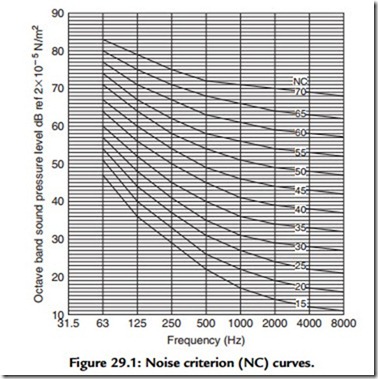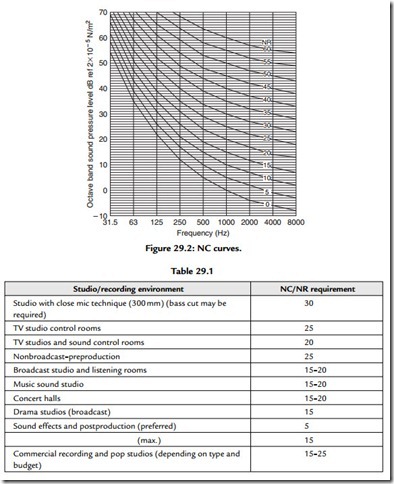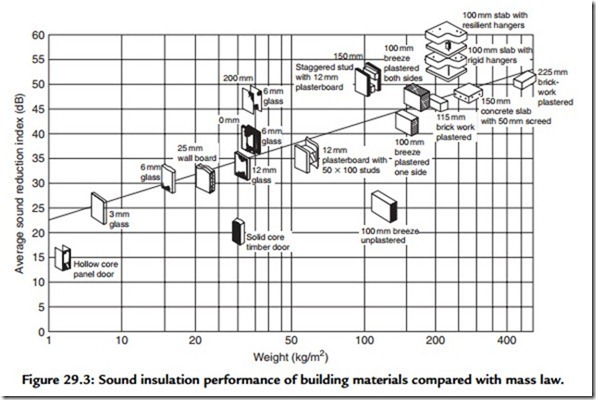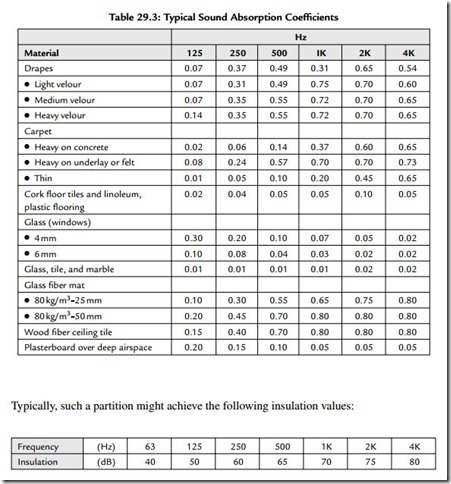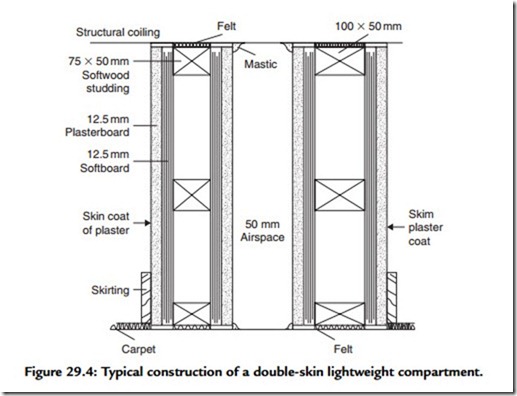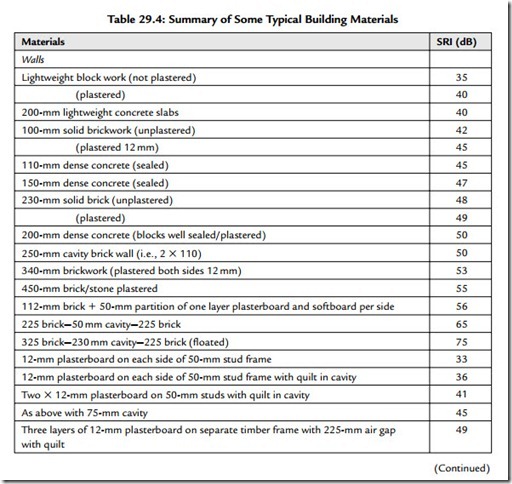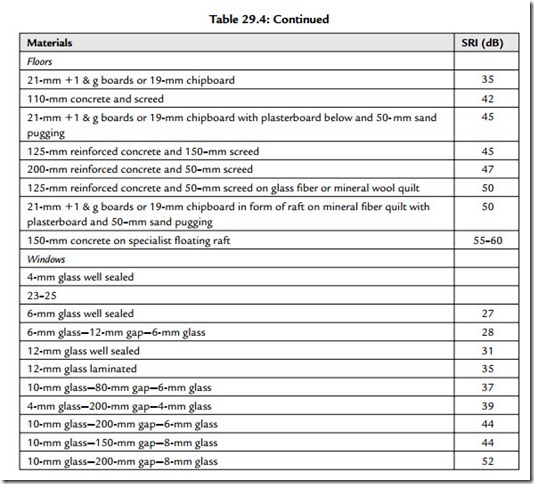Noise Control
The increased dynamic range of the hi-fi medium has led to corresponding decreases in the levels of permissible background noise in studios and control rooms.
A single figure rating (e.g., 25 dBA) is not generally used to describe the background noise requirement as it is too loose a criterion. Instead a set of curves that take account of the spectral (frequency) content of the noise are used. The curves are based on an octave or 1/3 octave band analysis of the noise and also take account of the ear’s reduced sensitivity to lower frequency sounds.
The curves used most frequently are the NC (noise criterion) and NR (noise rating) criteria. Figures 29.1 and 29.2 graphically present the two sets of criteria in terms of the octave band noise level and frequency. (Although as Figures 29.1 and 29.2 show, criteria are not exactly the same; the corresponding target criteria, e.g., NC20 or NR20, are frequently interchanged.)
The NC system is intended primarily for rating air conditioning noise, while the NR system is more commonplace in Europe and can be used to rate noises other than air conditioning. (An approximate idea of the equivalent dBA value can be obtained by adding 5 to 7 dB to the NC/NR level).
Table 29.1 presents typical design targets for various studio and recording formats. Many organizations, for example, the BBC, demand even more stringent criteria, particularly at low frequencies. From Table 29.1 and curves shown in Figures 29.1 and 29.2, it can be seen that the background noise level requirements are pretty stringent, typically being
25 dBA or less, which subjectively is very quiet. (The majority of domestic living rooms, considered by their occupants to be quiet, generally measure 30–40 dBA.)
The background noise level in a studio is made up from a number of different sources and components and for control purposes these may be split up into four basic categories:
● External airborne noise,
● External structure borne noise,
● Internally and locally generated noise,
● Internal noise transfer, Each source of noise requires a slightly different approach in terms of its containment or control.
Achieving low noise levels in modern studios is a complex and generally costly problem but any short cuts or short circuits of the noise control measures will destroy the integrity of the low noise countermeasures and allow noise into the studio.
External Airborne Noise
Here we are typically concerned with noise from local road traffic, aircraft, and railways. Any of these sources can generate levels of over 100 dB at low frequencies at the external facade of a building. Controlling such high levels of low-frequency noise is extremely difficult and costly. Therefore, if possible, when planning a sensitive acoustic area such as a studio, it is obviously preferable to avoid locations or buildings exposed to high external levels of noise. An extensive noise survey of the proposed site is therefore essential.
Wherever possible the walls to a studio or control room should not form part of the external envelope of the building. Instead a studio should be built within the main body of the building itself so a buffer area between the studio and external noise source can be created, for example, by corridors or offices or other noncritical areas. Similarly, it is not good practice to locate a studio on the top floor of a building. However, if it is not possible to create suitable buffer areas, a 1-m minimum separation should be created between external and studio walls or roof and ceiling etc.
Internally and Locally Generated Noise
Apart from being transmitted by sound pressure waves within the air, noise can also be transmitted by the building structure itself. Structural noise can be induced either directly by the vibration of the structure, for example, by locating the building over or adjacent
to a railway or underground train line, or sound pressure waves (particularly at low frequencies) can cause the structure itself to vibrate. Again, the best method of control is to separate the sensitive areas from such potential noise sources as structural isolation is required. One solution is to spend the available budget on the equipment of rubber pads, or literally steel springs if really effective low frequency isolation is required. However, the best solution is to choose the site carefully in the first place and spend the available budget on the equipment and acoustic finishes rather than on expensive structural isolation.
If the studio is to be built in a building with other occupants/activities, again a thorough survey should be conducted to establish any likely sources of noise, which will require more than usual treatment (e.g., machinery coupled into the structure on floors above or below the studio. This includes lifts and other normal “building services” machinery such as air conditioning plant, etc.).
Internal Noise Transfer
The biggest noise problem in most studios is noise generated or transmitted by the air conditioning equipment. Studios must provide a pleasant atmosphere to work in, which, apart from providing suitable lighting and acoustics, also means that the air temperature and humidity need to be carefully controlled. Sessions in pop studios may easily last 12 to 15 h. The studio/control room must therefore have an adequate number of air changes and sufficient fresh air supply in order for the atmosphere not to become “stuffy” or filled with cigarette smoke and so on.
It should be remembered that the acoustic treatments also tend to provide additional thermal insulation and in studios with high lighting capacity (e.g., TV or film) or where a large number of people may be working, the heat cannot easily escape, but is contained within the studio, requiring additional cooling capacity over that normally expected.
Large air conditioning ducts with low air flow velocities are therefore generally employed in studios with special care being taken to ensure that the air flow through the room diffuser grilles is low enough not to cause air turbulence noise (e.g., duct velocities should be kept below 500 ft3/min, and terminal velocities below 250 ft3/min). Studios should be fed from their own air conditioning plant, which is not shared with other parts of the building.
Ducts carrying air to and from the studios are fitted with attenuators or silencers to control the noise of the intake or extract fans. Cross talk attenuators are also fitted in ducts that serve more than one area, for example, studio and control room, to prevent the air conditioning ducts acting as large speaking tubes or easy noise transmission paths.
Studio air conditioning units should not be mounted adjacent to the studio but at some distance away to ensure that the air conditioning plant itself does not become a potential noise source. Duct and pipe work within the studio complex will need to be mounted with resilient mountings or hangers to ensure that noise does not enter the structure or is not picked up by the ductwork and transmitted to the studio.
Water pipes and other mechanical services ducts or pipes should not be attached to studio or control room walls, as again noise can then be transmitted readily into the studio.
Impact noise from footfall or other movement within the building must also be dealt with if it is not be transmitted through the structure and into the studio. A measure as simple as carpeting adjacent corridors or office floors can generally overcome the majority of such problems. Wherever possible, corridors adjacent to studios should not be used at critical times or their use should be strictly controlled. Main thoroughfares should not pass through studio areas.
Sound Insulation
Having created a generally suitable environment for a studio, it is then up to the studio walls themselves to provide the final degree of insulation from the surrounding internal areas.
The degree of insulation required will very much depend on the following
1. Uses of the studio, for example, music, speech, and drama.
2. The internal noise level target, for example, NC20.
3. Noise levels of the surrounding areas.
4. The protection required to the surrounding area (e.g., in a pop music studio, the insulation is just as much there to keep the noise in so that it will not affect adjoining areas or studios as it is to stop noise getting into the studio itself).
Appropriate insulation or separation between the control room and studio is also another very important aspect that must be considered here. The minimum value of sound insulation required between control room and studio is probably about 55–60 dB. Monitoring levels are generally considerably higher in studio control rooms than in the home. For example, 85 dBA is quite typical for TV or radio sound monitoring, whereas pop studio control rooms will operate in the high 90s and above.
Sound insulation can only be achieved with mass or with mass and separation. Sound- absorbing materials are not sound insulators, although there is much folklore that would have you believe otherwise. Table 29.2 sets out the figures, showing that only very high values of sound absorption produce usable sound reductions.
To put the figures used in Table 29.2 in perspective, a single 4.5-in. (112-mm) brick wall has a typical sound insulation value of 45 dB, and a typical domestic brick cavity wall 50–53 dB—and you know how much sound is transmitted between adjoining houses! Furthermore, typical sound-absorbing materials have absorption coefficients in the region of 0.7 to 0.9, which is equivalent to a noise reduction of only 5–10 dB.
Figure 29.3 shows the so-called mass law of sound insulation, which shows that sound insulation increases by approximately 5 dB for every doubling of the mass. A number of typical constructions and building elements have been drawn on for comparison purposes.
It should be noted that the sound-insulating properties of a material are also affected by the frequency of the sound in question. In fact the insulation generally increases by 5 dB for every doubling of frequency. This is good news as far as the insulation of high- frequency sound is concerned, but bad news for the lower frequencies.
Generally, a single value of sound insulation is often quoted—this normally refers to the average sound insulation achieved over the range 100 Hz to 3.15 KHz and is referred to as the sound reduction index (SRI). Sound transmission class (STC) in the United States is based on the average between 125 Hz and 4 KHz.)
An approximate guide to the performance of a material can be obtained from the 500-Hz value of insulation as this is often equivalent to the equated SRI. For example, our 112-mm brick wall will tend to have an SRI of 45 dB and have a sound insulation of 45 dB at 500 Hz, 40 dB at 250 Hz, and only 35 dB at 125 Hz, which begins to explain why it is always the bass sound or beat that seems to be transmitted. In practice, therefore, the studio designer or acoustic consultant first considers controlling break-in (or break-out) of the low-frequency sound components, as overcoming this problem will invariably automatically sort out any high-frequency problems.
From the graph shown in Figure 29.3, it can be seen that some pretty heavy constructions are required in order to achieve good sound separation/insulation. However, it is possible to also achieve good sound insulation using lightweight materials by using multilayered construction techniques.
Combinations of layers of plasterboard and softboard, separated by an airspace, are used frequently. Figure 29.4 shows a typical construction. The softboard is used to damp out the natural resonances of the plasterboard, which would reduce its sound insulation. The airspace may also be fitted with loose acoustic quilting (e.g., fiber-glass or mineral wool, to damp out any cavity resonances).
Note that an airtight seal has to be created for optimum sound insulation efficiency. Also note that different sized airspaces are used.
A double-leaf construction as shown in Figure 29.4 can achieve a very good level of sound insulation, particularly at mid and high frequencies.
However, the final value will very much depend on the quality of the construction and also on the presence of flanking transmission paths, that is, other sound paths, such as ducting or trunking runs, that short circuit or bypass the main barrier.
Triple layer constructions and multiple layer heavy masonry constructions can be employed to achieve improved levels of insulation, particularly at the lower frequencies.
Studios can also be built from modular construction assemblies based on steel panels/ cavities lined with sound-absorptive material.
The following table compares a double leaf steel panel construction with an equivalent thickness (300 mm) of masonry wall construction.
Again it must be remembered that when it comes to sound insulation, large differences frequently occur between the theoretical value (i.e., what can be achieved) and the actual on-site value (i.e., what is actually achieved). Great care has to be taken to the sealing of all joints and to avoid short-circuiting panels by the use of wall ties or debris within the cavities. Furthermore, where doors or observation windows penetrate a wall, particular care must be taken to ensure that these do not degrade the overall performance. For example, the door or window should have the same overall sound insulation capabilities as the basic studio construction.
Studio doors should therefore be solid core types, and are frequently fitted with additional lead or steel sheet linings. Proprietory seals and door closers must be fitted to form an airtight seal round the edge of the door. Soft rubber compression or magnetic sealing strips are commonly employed while doors are rebated to help form a better joint. (Wherever possible a sound lock should be employed, i.e., two doors with an acoustically treated space between, such that one door is closed before the other opened.) Other methods of improving door insulation include the use of two separate doors on a single frame, each fitted with appropriate seals.
Control room windows may be either double or triple glazed depending on the performance required. Large airspaces, for example, 200–300 mm plus, are necessary in order to achieve appropriate insulation. Tilting one of the panes not only helps to cut down visual reflections, but also breaks up single frequency cavity resonances, which reduce the potential insulation value significantly. The reveals to the windows should also be lined with sound-absorbing material to help damp out cavity resonances.
Window glass needs to be much thicker/heavier than typical domestic glazing. For example, a typical 0.25-in., 6-mm domestic window would have a sound insulation performance of around 25–27 dB (21–23 dB at 125 Hz), whereas a 200-mm void fitted with 12- and 8-mm panes could produce an overall SRI of 52 dB (31 dB at 125 Hz).
Special laminated windows and panes can also be used to improve performance.
Studios are frequently built on the box within a box principle, whereby the second skin is completely isolated from the outer. This is achieved by building a “floating” construction. For example, the floor of the studio is isolated from the main structure of the building by constructing it on resilient pads or on a continuous resilient mat. The inner walls are then built up off the isolated floor with minimal connection to the outer leaf. The ceiling is supported from the inner leaves alone and so does not bridge onto the outer walls, which would short-circuit the isolation and negate the whole effect. With such constructions, particular care has to be taken with the connection of the various services into the studio. Again attention to detail is of tantamount importance if optimum performance is to be achieved. Note that the sealing of any small gaps or cracks is extremely important, as shown by the plastered and unplastered walls in Table 29.4.
